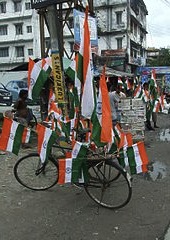The Emergence of Two Indias
India’s urban middle class turns away from the public sector.
November 2, 2013

The middle class in India is fast being converted into a private flock of individuals, very large in size, but with a diminishing relationship with the state. With the 300 million strong urban middle class turning its back on public institutions and the rest of India largely dependent on state doles, two Indias seem to have emerged.
If the educated middle class is taken out of the Indian political equation, we are left with a large section of population that is ill-fed, illiterate and ill-informed.
Politics in the country has then been reduced to two forms: (a) crude left-wing populism, instantly clung to by a large section of deprived population and (b) identity politics (the politics of religion, ethnicity and caste) which seek to play into the divisions within the Indian society. This risks taking the country back to its regressive past.
Meanwhile, for the urban middle class – content with private jobs, private healthcare and private schooling – any sense of satisfaction will no longer be tied to the state in any form, except for the obvious: It will rely on the state for defense and security, and the state in turn will rely back on the middle class for personal income tax collection.
That risks turning a vital part of India into a U.S. Republican-style group that resents the state – apart from its defense role – and fails to see the value of the various services it provides.
According to India’s 2012 Economic Survey, public sector jobs were created at a rate of 0.4% from 2009 to 2010, which compares to a growth rate of 4.5% in the private sector.
While the public sector continues to employ more people in absolute numbers, at this rate of growth the country’s private sector will be as strong as, if not stronger than, the public sector in a decade’s time.
Middle class detachment from public services
A 2012 Frontline magazine report on the country’s civil services found that: “With the urban youth opting for lucrative private jobs in the era of economic globalization, the civil services [has] started attracting more and more graduates from rural and semi-urban areas.”
This finding underscores that the educated urban middle class’s detachment from public institutions is beginning to look more and more permanent.
This detachment plays out in other areas as well. The education sector too is deeply market-driven, with almost every parent desiring for his child an ‘efficient’ private schooling. Private schools’ share of total enrollment in urban India was as high as 40% way back in 2002.
In addition, over 70% of total health spending in India is privately met. Most of the middle class’s health spending constitutes out-of-pocket outlays by individuals. Many choose not to access public healthcare. This has to do with the urban middle class’s fondness for everything ‘private.’
Good governance via the private sector
Even as the public sector in India is largely perceived to be inefficient, the agenda of good governance – which is topmost in the minds of India’s middle class – is seen to be fulfilled by the private sector.
That India’s public institutions are also beset with corruption and red-tapism, further fuels the citizens’ private retreat.
Also, in a confirmation of the urban middle class’s disdain for anything ‘public’, Indian respondents overwhelmingly opine in a global survey by Transparency International that its political parties, the police, public officials and civil servants are the most corrupt.
This decay of public institutions, in fact, straddles sectors ranging from education to health. For the 300 million strong urban middle class in India who manage to afford it, the private sector appears to be filling the void left by the seemingly non-performing public sector.
In India’s rural hinterlands, the state-citizen relationship is sustained nonetheless. Not only is there a state-funded job guarantee in the form of National Rural Employment Guarantee Act (NREGA), but more importantly, rural Indians, most of them living below the poverty line, principally depend on the state for public provisions.
This help includes the Public Distribution System for allocating the country’s concentrated food grain supplies, as well as essential services like economical public schooling for their poor children. A large section of the population thus continues to be reliant on, and intricately linked, to the state. But the most vibrant part of India’s citizenry is not.
Distressing as it may sound, India today is precariously divided into two halves wherein one half is essentially an island of private individuals almost wholly detached from the state, and the other in the bread line.
There can be an endless debate on the benefits and shortcomings of privatization and on the merits of neoliberal ideals. However, the dangers of converting a substantial swathe of India’s population into a private clan devoid of any links to the state and its institutions should not be overlooked.
Takeaways
The middle class in India is fast being converted into a private flock.
For India’s poor, two political strains have risen. A crude, left-wing populism and a divisive identity politics.
India’s private sector appears to be filling the void left by the seemingly non-performing public sector.
For the most vibrant part of India's citizenry, the state increasingly seems irrelevant to their lives.
Like US Republicans, for India's middle class, the role of the state beyond defense seems questionable.

